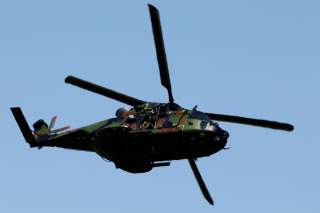How a French Sniper Daringly Saved a Comrade's Life—by Tying Him to a Helicopter
Amazing.
Key point: Despite all of the jokes, France's military is highly trained and its special forces are no joke. Paris has been fighting terrorism in Africa for years now and their soldiers take their jobs seriously.
In January 2013, a heavy French force struck Islamic militants who had been advancing across Mali. Paris deployed 4,000 troops plus tanks, helicopters and warplanes.
Operation Serval, which France’s Western and African allies strongly supported, routed the militants. And a year and a half later, Paris expanded the operation—and renamed it Barkhane—to include counterterrorism missions across the Sahel region of Sub-Saharan Africa, including Niger and Chad.
Six years later the fighting continues. Sometimes in dramatic fashion and often involving helicopters, as was the case on June 14, 2019 when militants shot down over Mali an SA342 Gazelle helicopter belonging to Aviation Légère de l'Armée de Terre -- French army aviation.
“Both pilots were heavily wounded but were able to make a controlled crash-landing,” Scramble reported. “A third crew member, a commando sniper, with only minor injuries was able to extract the heavily wounded pilots from the helicopter.”
The Gazelle, deployed in support of Operation Barkhane, was shot down by jihadists near the border of Mali and Niger during a patrol mission near Liptako. The pilots and French ground troops from Niger and Mali got involved in serious fighting with militants that are believed to be part of Islamic State in the Greater Sahara.
The SA342 that gave overhead support received multiple hits in the engine compartment by small-caliber weapons … Subsequently, an engine fire started that resulted in the loss of power. An autorotation landing in brown-out conditions followed, but due to its low altitude this did not work out properly.
Nearby, an ALAT Tiger attack helicopter was also involved in the fight, its crew decided to rush to the crash site to give top cover for the three crew members, at the risk of being shot, too.
Upon arrival at the scene, the Tiger crew discovered that the pilots were seriously wounded and they decided to land. With the help of the sniper commando, they strapped both pilots to the outside of the Tiger and quickly returned to base to allow for immediate treatment of the airmen.
The sniper commando ... remained at the crash site and destroyed the Gazelle with explosives. He was picked up by another helicopter soon after, and extracted to a safe location.
All three crew members were transported back to France for further treatment in a military hospital.
“Helicopters have been a significant element of the French army's counter-terror operations in Mali since Operation Barkhane — named after crescent-shaped dunes in the Sahara Desert — began in August 2014,” Rotor & Wing reported.
Twenty-one helicopters --Tigers, Caimanes, Pumas, Cougars, Gazelles and Chinooks -- and 4,500 personnel are supporting the operation. The three Royal Air Force HC Mk5 Chinooks arrived in Mali in July [2018] to transport supplies and personnel for French and other military forces.
The Boeing Chinooks, equipped with advanced avionics and the Boeing Digital Automatic Flight Control System, have helped to sustain French combat operations and to keep troops off the roads, which are vulnerable to improvised explosive devices, according to the RAF.
Many attack helicopters, in theory, can transport troops the way the French Tiger did in Mali. In 2007 in Afghanistan’s Helmand province, two British AH-64 Apache gunships carried four marines into a Taliban-controlled riverside fort to retrieve the body of a British soldier who had died in an earlier assault.
“Two Apaches landed and four volunteer marines strapped themselves to the aircraft wings using harnesses,” The Guardian reported.
Dodging Taliban gunfire -- and with four marines lying across the wings in the manner of the heroes of the Second World War film Flight of the Phoenix -- the two Apaches sped across the river and landed outside the Taliban fort. The marines unstrapped themselves and searched for Lance Corporal [Mathew] Ford. Having recovered his body, they strapped it to one of the Apaches and safely crossed the river.
Defence sources described the rescue as an unprecedented operation. Apaches cannot carry passengers -- the small fuselage is crammed with instruments and weapons systems and can barely accommodate two pilots. But there are attachments on the wings to which soldiers can harness themselves in an emergency.
U.S. Air Force A-10s flew top cover for the daring British operation. One A-10 pilot recalled his shock when he realized what the British were doing. “As I passed abeam one Apache, I glanced high left to see a man, leaning over the stubby helicopter wing, unloading his rifle on the enemy.”
David Axe serves as Defense Editor of the National Interest. He is the author of the graphic novels War Fix, War Is Boring and Machete Squad. This first appeared in 2019.
Image: Reuters.

